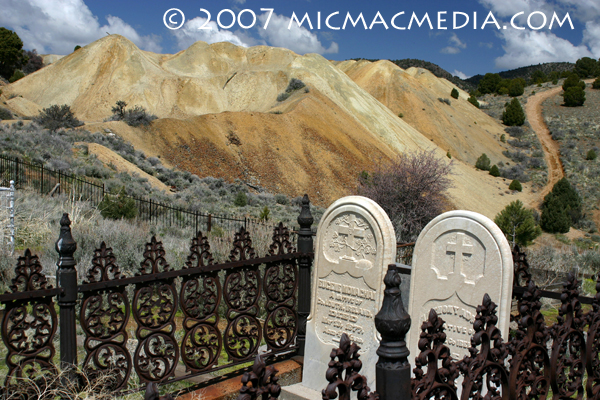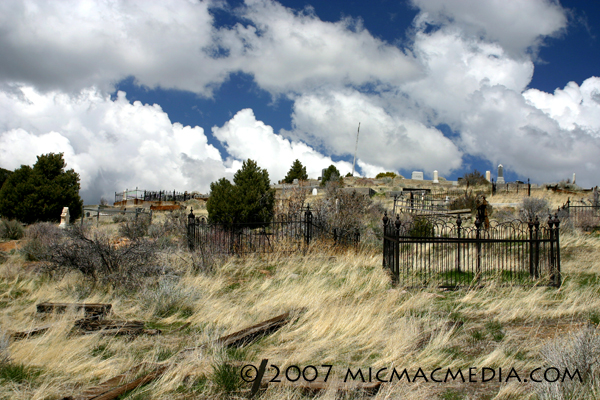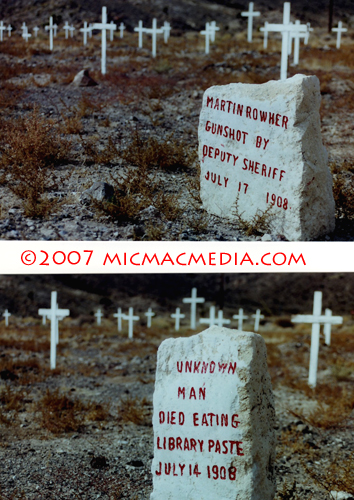 |
|
|
Follow Mark on Facebook for more stories |
||
 |
|||||
|
Tahoe Nugget #124: Halloween Cannibal Style In the spirit of Halloween, here's a short medley of western vignettes for those with a stout heart and sense of humor: Murder and cannibalism are two of modern society's most serious legal and cultural taboos. In 1859, a Colorado gold rush lured thousands of greenhorns to the Rocky Mountains. Eastern editors filled newspapers with fantastic tales of the wealth to be had near Pike's Peak, and proclaimed the diggings far richer than those of California. Throngs of hopeful youths, needy farmers, and out-of-work shopkeepers rushed from the Mississippi Valley to Kansas Territory. Spurning all words of caution, these opportunistic '59ers grabbed a handcart, backpack, or wheelbarrow and headed west. Many narrowly missed death by starvation and some were reduced to cannibalism. The Blue brothers acquired a sinister place in history when one reached the mines only after subsisting on the bodies of his two siblings who apparently died in route. Charles Gardner, initially nicknamed "Phil" for his hometown of Philadelphia, later earned the moniker "Cannibal Phil" after setting out on a journey with an Indian companion and returning alone. The two men had been caught in a blizzard and given up for dead, but Gardner surprised everyone by reappearing several days later. The celebratory mood darkened, however, when Phil unpacked his mule and pulled out a shriveled human leg. As his companions recoiled in horror, he threw the limb to the ground saying, "There, damn you, I won't have to gnaw on you any more." Not long after, Cannibal Phil really secured his gruesome reputation when he survived being marooned in a mountain snowstorm by consuming his female companion. The most infamous story of cannibalism in the West is the lurid tale of Alferd G. Packer. Packer was a 31-year-old Colorado-born prospector, tall and muscular, with coal-black hair and a bushy mustache. Packer led a group of about 20 eager young prospectors from Salt Lake City, Utah, to a new gold strike near Breckenridge, Colorado. The group was well equipped with horses, wagons, and provisions when they left Salt Lake in late November 1873, but by January one of the worst and coldest winters on record had trapped the men at a place now called Cannibal Plateau. Deep snow kept them from hunting, and the party eventually ran out of food. Packer told his clients that he would get them back to civilization but he himself was lost. Luckily they encountered the tribe of Chief Ouray, a friendly Indian leader, who offered them flour, meat and other vital supplies. Chief Ouray assured the prospectors that they could remain in the tribe's teepees until warmer weather, but sagely advised the men to forget the gold and return to Salt Lake City. In early February, several men hiked out into the brutal snow and cold, but survived only by killing an emaciated cow with their bare hands and drinking its warm blood, which gave them the strength to reach a remote government cattle camp. Meanwhile, their companions back at Chief Ouray's winter camp convened a council in which ten men elected to return to Utah. Packer laughed in his distinctive high-pitched voice and called them quitters; he persuaded five of the remaining men to accompany him to the diggings where they would all become rich. That was the last anyone saw of the six men until weeks later when a wild-eyed Alfred Packer staggered into the Los Piños Indian Agency, haggard and alone. Delirious, he told the authorities an incoherent story of murder and survival. Packer explained that the prospecting party had been caught in a series of vicious Colorado blizzards and run out of provisions. He offered conflicting accounts for the deaths of his partners, but the most consistent and lucid one has him returning to camp one day after searching for a way out of the snow, where he found that a crazed Shannon Bell had murdered the other four men with a hatchet. When Bell attacked him, Packer shot him dead in self-defense. To avoid starvation, Packer admitted boiling up the meat from his companions and eating it. In 1989, a forensic team exhumed the bodies of the Packer party. Physical evidence showed that several of the men had been killed by multiple ax blows to the head. Bell's skeleton bore no bullet marks, supporting Packer's assertion that he shot him through the stomach. From cut marks on the bones, the team determined Packer had filleted the dead men. Newspapers dubbed Packer "the Ghoul of the San Juans" and printed sensational headlines like "A Cannibal Who Gnaws on the Choice Cuts of his Fellow Man." Alferd Packer was imprisoned in a jail cell, but an unknown benefactor passed him a knife blade with which he unlocked his irons and escaped. He eluded the law for nine years until one of the original prospectors from 1873 recognized Packer's distinctive voice in a Wyoming roadhouse and turned him over to Colorado authorities that wanted to prosecute him for the killings. In 1884, ten years after the crime of which he was accused, Packer was tried, convicted, and sentenced to 40 years in prison for murder — eight years for each of his five alleged victims. During Packer's sentencing, Judge M. B. Gerry lamented, "Packer, there were seven registered Democrats in Hinsdale County and you ate five of them!" On January 8, 1901, after 16 years as a model prisoner, Packer was granted parole by outgoing Colorado governor Charles S. Thomas on his last day in office. The memory of Alferd Packer lives on today. In 1968, students at the University of Colorado at Boulder named their new cafeteria grill the Alferd G. Packer Grill with the slogan "Have a friend for lunch!" Photo #1: Western cemeteries are filled with the bones of hard rock miners. Note mine tailings (waste rock) in background. Photo #2: Wind blown burial ground outside Virginia City, Nevada. Photo #3: Not everybody died in the mines. Note deaths occurred 3 days apart. Goldfield, Nevada. Photo#4: Boo! This guy haunts the railroad tunnels on Donner Summit.
|
|||||
|




